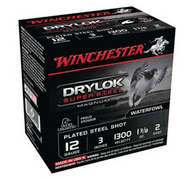How To Read Shotgun Shells?
Aug 17th 2023
Reading shotgun shells involves deciphering the critical information imprinted on the ammunition to make informed choices for shooting or hunting activities. Start by identifying the gauge, which represents the shotgun's bore diameter. This ensures the shell fits your firearm properly. Next, consider the shell length, usually indicated in inches or millimeters, which must match your shotgun's chamber length. Finally, focus on the numbers displayed on the shell, typically found on the shell's side or top. These numbers denote the shot size contained within the shell and play a vital role in determining the shell's suitability for different types of game or shooting scenarios. By understanding these markings, you can confidently select the right ammunition for your specific needs.
What Do The Numbers Mean On A Shotgun Shell?
The numbers engraved on a shotgun shell serve as a code that reveals the ammunition's shot size. This numbering system can initially seem perplexing, as larger numbers correspond to smaller pellets and vice versa. For instance, a shell labeled with #9 shot contains numerous small pellets, making it apt for clay target shooting or hunting small game due to its widespread pattern.
Conversely, a shell marked with #00 shot houses fewer, larger pellets, which are effective for close-range hunting or self-defense situations where stopping power is paramount. These numbers indicate the diameter of the pellets, influencing factors like pattern density and striking energy. As the number decreases, the pellet size increases, with each size catering to specific shooting needs. Understanding these numbers empowers shooters to choose the right ammunition for their intended targets, optimizing accuracy, and ethical hunting or shooting results.
Shotgun Shot Sizes: Targeting Game with the Right Ammunition
- #9 Shot: Often used for shooting small game like quail and dove, as well as for target shooting due to its high pellet count.
- #8 Shot: Versatile shot size suitable for a variety of uses, including skeet and trap shooting, as well as hunting small game like rabbits and squirrels
- #7.5 Shot: Popular choice for clay target sports like trap, skeet, and sporting clays, and can also be effective for upland bird hunting.
- #6 Shot: Suitable for hunting larger upland game birds like pheasants and chukars, as well as for shooting small to medium-sized waterfowl.
- #5 Shot: Effective for hunting turkey at medium ranges, as well as for larger waterfowl hunting
- #4 Shot: Often used for hunting ducks and geese at longer ranges, and also for hunting large game birds like wild turkey.
- #3 Shot: Primarily used for waterfowl hunting, particularly ducks and geese, where longer range shots are common.
- #2 Shot: Suitable for hunting ducks, geese, pheasants, and other medium-sized game birds at moderate distances.
- #1 Shot: Used for hunting larger waterfowl and game birds, especially when a longer range shot is necessary.
- #00 (Double-ought) Shot: Commonly used for self-defense due to its larger pellets, providing good stopping power at close ranges.
- #000 (Triple-ought) Shot: Similar to #00 shot but with even larger pellets, suitable for self-defense and hunting larger game.
Keep in mind that these are general guidelines, and the choice of shot size can vary based on factors such as the specific game being hunted, the range of shots expected, and local hunting regulations. Always consult local guidelines and recommendations before selecting your shotgun ammunition.
How Does Shot Size Affect The Spread Of Pellets?
Shot size plays a significant role in determining the effective range and pattern of pellets when a shotgun is fired. Larger shot sizes, like #00 or #000 buckshot, contain fewer but larger pellets. These larger pellets retain their energy and velocity over greater distances, allowing them to maintain their effectiveness at a more extended range. This makes them suitable for close to moderate ranges, making them popular choices for self-defense and hunting scenarios where the target might be at a distance.
On the other hand, smaller shot sizes, such as #7.5 or #9, consist of numerous smaller pellets. While they might not carry as much energy as larger pellets, they create denser patterns when fired, making them effective for targets at closer ranges. These patterns help compensate for the individual pellets' reduced energy over distance by increasing the likelihood of hitting the target. Therefore, the shot size you choose depends on your intended shooting range and the desired pattern density, with larger shot sizes excelling at longer distances and smaller shot sizes being more suitable for close encounters or targets that require a tighter pattern.
Conclusion
In summary, understanding how to read shotgun shells is crucial for making informed decisions in shooting and hunting. By decoding the gauge, shell length, and shot size numbers, you ensure proper firearm compatibility and select the right ammunition for your purpose. Shot size significantly influences the pattern and range of pellets. Larger shot sizes like #00 buckshot maintain energy over distance, suitable for medium ranges, while smaller sizes like #9 offer denser patterns for close encounters. Mastering these aspects enhances shooting accuracy and ethical hunting practices, making you a more effective and responsible shooter or hunter.



